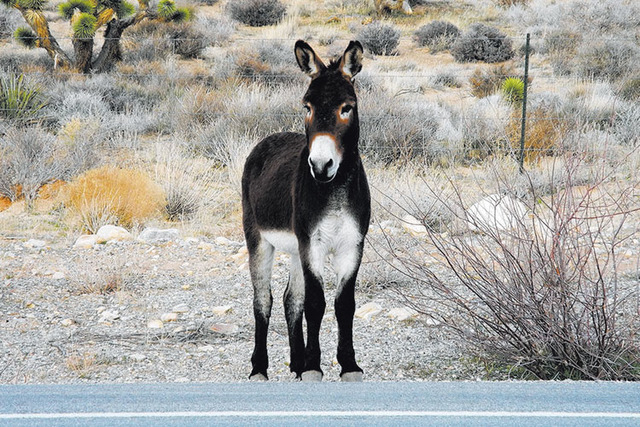Burro feedings lead to crashes, officials say
Don’t feed the burros.
The advice — and law — could save the lives of burros and drivers along state routes 159 and 160.
Federal officials warn that burros and wild horses near and around Red Rock Canyon have grown accustomed to frequent contact with people who feed them on the side of the road, which could lead to crashes.
One such crash happened last week, when a wild burro wandered onto Route 159 and was struck, causing a three-vehicle pileup.
The Tuesday crash left a woman pinned in her vehicle. She had to be extracted by emergency personnel and taken to University Medical Center with non-life threatening injuries, according to the Nevada Highway Patrol.
The burro was killed.
Fences on either side of Route 159, the highway connecting Blue Diamond and Red Rock Canyon, weren’t enough to keep the burro from entering the road and causing the crash.
As long as people continue to feed the burros, crashes will happen, said Kristen Cannon, a spokeswoman for the Bureau of Land Management.
“I know people probably think they’re doing them a favor by offering a carrot or Cheeto,” Cannon said, “but people who feed the burros are actually hurting them more than helping them.”
Animals that become used to humans feeding them are less afraid to approach vehicles and more likely to enter the roadways.
In the past four years, there have been 22 reports of wild horses or burros being hit throughout Red Rock Canyon, which stretches from Goodsprings to Pahrump, according to the BLM.
But safeguards implemented by authorities to prevent vehicles from crashing into burros, including fences, signs and fines for people feeding burros, could be having the desired effect.
Last year there was one crash between a vehicle and a burro and 18 calls reporting burros in roadways, trooper Loy Hixson said. The number of calls was down from 39 in 2012, when there were no crashes, Hixson said.
The BLM uses several venues to inform visitors and motorists of the dangers of interacting with burros.
Twelve signs are posted along routes 159 and 160 warning that feeding the burros can lead to tickets costing as much as $500 in fines, Cannon said.
And in addition to fences, signs and ticketing along the highways, the bureau has an adoption program aimed at removing burros from the high-traffic area in and around Red Rock Canyon.
In September 2012, 27 burros were removed from Blue Diamond and placed in the program. The burros were lured into captivity by a BLM employee shaking a bag of rocks, which the burros recognized as bags of food.
They were then branded on the neck and auctioned off into private ownership.
While adoptions do a great deal to remove the animals from danger, many wild burros still linger near the roads waiting for motorists to stop and feed them.
Their proximity to the road is especially dangerous at night, Cannon said.
Because their eyes aren’t as reflective as a deer’s, burros are very difficult to see at night.
“It is crucial to obey the speed limit and drive carefully to avoid hitting these animals,” Cannon advised.
The best advice for daytime travelers is don’t stop to feed the burros, Cannon said. “These animals are perfectly capable of feeding themselves.”
Contact reporter Kimber Laux at klaux@reviewjournal.com or at 702-383-0391.

















